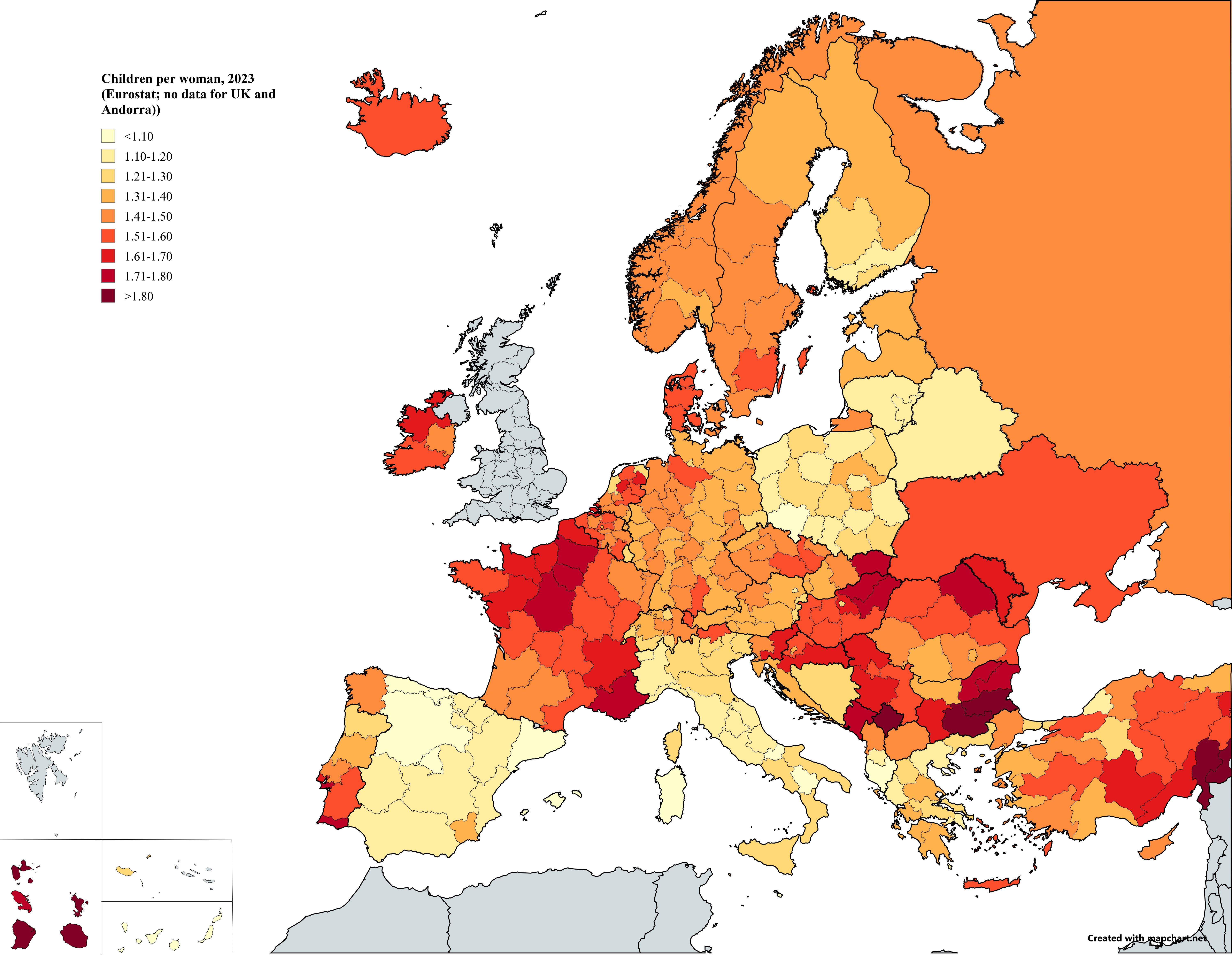Children per Woman in Europe Map


Alex Cartwright
Senior Cartographer & GIS Specialist
Alex Cartwright is a renowned cartographer and geographic information systems specialist with over 15 years of experience in spatial analysis and data...
Geographic Analysis
What This Map Shows
The "Children per Woman in Europe Map" provides a visual representation of the fertility rates across various European countries in 2023. Specifically, this map illustrates the average number of children born per woman in different regions, highlighting significant demographic trends that can influence economic, social, and cultural landscapes. By examining this visualization, we can gain insights into the reproductive choices of women across Europe and how these choices vary by country.
Deep Dive into Fertility Rates in Europe
Fertility rates are a crucial demographic indicator, reflecting not only the reproductive behavior of women but also wider socio-economic conditions, cultural norms, and policies surrounding family life. On average, the fertility rate in Europe has been on a downward trend for several decades, leading to an aging population and potential challenges for future labor markets and social services.
Interestingly, the European average fertility rate hovers around 1.5 children per woman, which is below the replacement level of 2.1 needed to maintain a stable population size. This decline can be attributed to various factors. For instance, increased access to education and employment opportunities for women often leads to delayed childbirth and smaller family sizes. Additionally, economic uncertainties and the high cost of living in many urban areas make raising multiple children less feasible for many families.
Cultural attitudes towards family and child-rearing also play a significant role. In Southern Europe, countries like Italy and Spain see lower fertility rates, with averages around 1.3, possibly due to traditional family structures being challenged by modern lifestyles and economic pressures. Conversely, some Eastern European countries such as Albania and Kosovo have higher rates, often exceeding 1.7 children per woman, reflecting different socio-economic conditions and cultural expectations surrounding family life.
Moreover, government policies can impact fertility rates. For example, countries like France and Sweden, known for their family-friendly policies that include parental leave and subsidized childcare, maintain higher fertility rates of around 1.8 and 1.7, respectively. These countries provide a social safety net that encourages families to have more children, illustrating the significant role of policy in shaping demographic trends.
Regional Analysis
When examining the map, distinct regional patterns emerge. Western Europe generally showcases lower fertility rates compared to Eastern Europe. For instance, Germany and the Netherlands report rates of about 1.5 and 1.6, respectively, indicating a trend where urbanization and increased female workforce participation correlate with smaller families.
In contrast, Eastern European nations like Poland and Hungary, while also facing declining rates, have seen some resurgence in recent years due to government incentives aimed at encouraging higher birth rates. Interestingly, Hungary’s government has implemented various financial support measures to stimulate family growth, resulting in a slight increase in fertility rates in recent years.
Northern Europe also presents a unique case, with countries like Denmark and Finland maintaining fertility rates around 1.7. This region tends to balance high living standards with strong social policies that support families, thereby fostering environments where having children is more manageable.
Southern Europe, however, faces a more complex challenge. The Mediterranean countries continue to struggle with low fertility rates, compounded by economic instability and high youth unemployment. The cultural shift towards prioritizing careers and personal freedom is evident, leading to delayed marriages and childbearing.
Significance and Impact
Understanding fertility rates is vital for addressing broader socio-economic issues, including workforce sustainability, healthcare, and economic growth. A declining birth rate can lead to significant demographic shifts, such as an aging population that may place increased pressure on pension systems and healthcare services. Countries with low fertility may face labor shortages, which can hinder economic growth and innovation.
Interestingly, projections indicate that if current trends continue, several European countries may experience significant population declines by 2050, leading to potential challenges in maintaining public services and economic vitality. Conversely, nations with higher fertility rates may see a demographic bulge, which can provide a youthful workforce but also necessitates adequate planning for education and employment.
In conclusion, the fertility rates illustrated on the "Children per Woman in Europe Map" are not just numbers; they represent the evolving dynamics of society, culture, and economy. As Europe navigates these demographic changes, understanding and addressing the underlying factors influencing fertility will be crucial in shaping a sustainable future for the continent.
Visualization Details
- Published
- September 26, 2025
- Views
- 50
Comments
Loading comments...